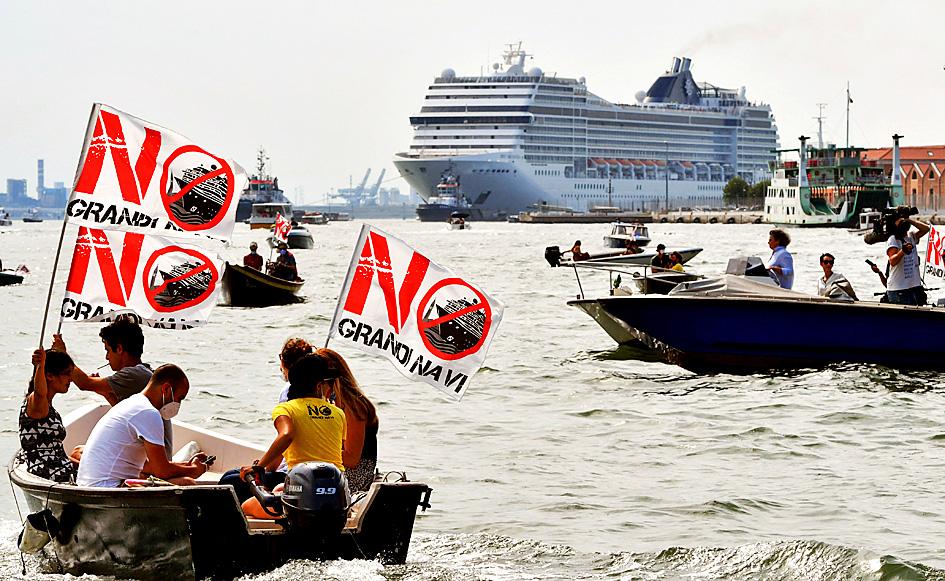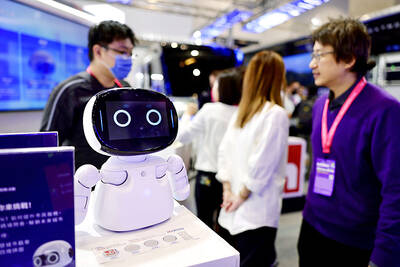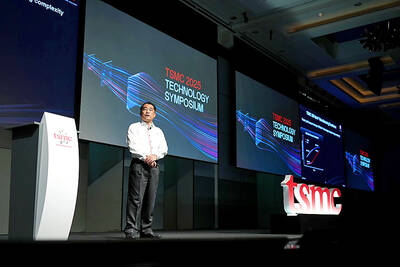The first cruise ship to leave Venice since COVID-19 restrictions were eased set sail on Saturday, but some local residents protested over the return to normal, unhappy about the passage of giant liners through the historic lagoon city.
Hundreds of people rallied on land, and small boats fluttering flags saying “No big ships” surrounded and followed the 92,000-tonne MSC Orchestra as it departed Venice port en route for Croatia and Greece.
“We are here because we are against this passage, but also against a model of tourism that is destroying the city, pushing out residents, destroying the planet, the cities, and polluting,” said Marta Sottoriva, a 29-year-old teacher and Venice resident.

Photo: AFP
However, port authorities, workers and the city government welcomed the presence of the Orchestra, operated by MSC Cruises, seeing it as a symbol of business starting after the health crisis that hit hard at the cruise industry and the wider travel sector.
“We are happy to be back ... to restart the engines. We care a lot about Venice and we’ve been asking for a stable and manageable solution for ships for many years,” said Francesco Galietti, national director for the trade group Cruise Lines International Association.
Some residents have been urging governments for years to ban large cruise ships and other big vessels from passing through the lagoon and docking not far from the famed St Mark’s Square.
Campaigners worry about safety and the environment, including pollution and underwater erosion in a city already in peril from rising sea waters.
“The struggle is very long, I think we are against very big financial interests,” Marco Baravalle, a 42-year-old researcher, and member of the No Grandi Navi (“No Big Ships”) group.
He and other protesters were worried that “everything will go back to what we had before the pandemic,” he added.
Italy’s government in April ruled that cruise ships and container vessels must not enter Venice’s historic center, but rather dock elsewhere.
However, the ban would not take effect until terminals outside the lagoon have been completed, and a tender for their construction has not been launched yet.
Part of the traffic might be diverted to the nearby port of Marghera starting from next year.
The Orchestra was escorted outside the port not just by small vessels protesting, but by tugboats that saluted it with water sprays, a sea tradition reserved for special occasions.
The 16-deck ship can carry more than 3,000 passengers and 1,000 crew, but for this voyage would be sailing at only half capacity due to COVID-19 social distancing rules.
“It’s an important day for us, for 4,000 workers and many others who work in this sector. We are starting again after over 17 months, finally there is light at the end of the tunnel,” said Alessandro Santi, chairman of the Federlogistica business group.
He said the port community favored the bans, but alternatives had to be found given the importance of tourism for the city.

DEMOGRAPHICS: Robotics is the most promising answer to looming labor woes, the long-term care system and national contingency response, an official said Taiwan is to launch a five-year plan to boost the robotics industry in a bid to address labor shortages stemming from a declining and aging population, the Executive Yuan said yesterday. The government approved the initiative, dubbed the Smart Robotics Industry Promotion Plan, via executive order, senior officials told a post-Cabinet meeting news conference in Taipei. Taiwan’s population decline would strain the economy and the nation’s ability to care for vulnerable and elderly people, said Peter Hong (洪樂文), who heads the National Science and Technology Council’s (NSTC) Department of Engineering and Technologies. Projections show that the proportion of Taiwanese 65 or older would

Nvidia Corp yesterday unveiled its new high-speed interconnect technology, NVLink Fusion, with Taiwanese application-specific IC (ASIC) designers Alchip Technologies Ltd (世芯) and MediaTek Inc (聯發科) among the first to adopt the technology to help build semi-custom artificial intelligence (AI) infrastructure for hyperscalers. Nvidia has opened its technology to outside users, as hyperscalers and cloud service providers are building their own cost-effective AI chips, or accelerators, used in AI servers by leveraging ASIC firms’ designing capabilities to reduce their dependence on Nvidia. Previously, NVLink technology was only available for Nvidia’s own AI platform. “NVLink Fusion opens Nvidia’s AI platform and rich ecosystem for

Taiwan Semiconductor Manufacturing Co (TSMC, 台積電) yesterday said it is building nine new advanced wafer manufacturing and packaging factories this year, accelerating its expansion amid strong demand for high-performance computing (HPC) and artificial intelligence (AI) applications. The chipmaker built on average five factories per year from 2021 to last year and three from 2017 to 2020, TSMC vice president of advanced technology and mask engineering T.S. Chang (張宗生) said at the company’s annual technology symposium in Hsinchu City. “We are quickening our pace even faster in 2025. We plan to build nine new factories, including eight wafer fabrication plants and one advanced

‘WORLD’S LOSS’: Taiwan’s exclusion robs the world of the benefits it could get from one of the foremost practitioners of disease prevention and public health, Minister Chiu said Taiwan should be allowed to join the World Health Assembly (WHA) as an irreplaceable contributor to global health and disease prevention efforts, Minister of Foreign Affairs Lin Chia-lung (林佳龍) said yesterday. He made the comment at a news conference in Taipei, hours before a Taiwanese delegation was to depart for Geneva, Switzerland, seeking to meet with foreign representatives for a bilateral meeting on the sidelines of the WHA, the WHO’s annual decisionmaking meeting, which would be held from Monday next week to May 27. As of yesterday, Taiwan had yet to receive an invitation. Taiwan has much to offer to the international community’s